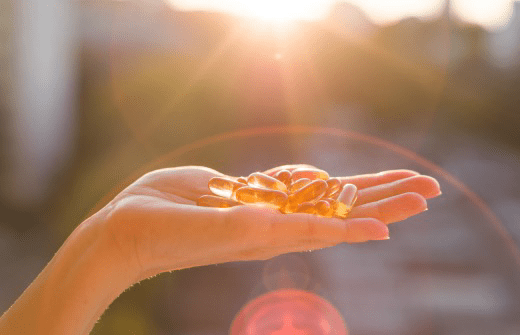Pomimo powszechnego stosowania suplementacji jodem na całym świecie, niedobór jodu pozostaje poważnym problemem zdrowotnym w Europie. W 2004 roku szacowano, że około 2 miliardy ludzi na świecie było narażonych na niedobór jodu, z czego około 20% dotyczyło Europy. Chociaż kretynizm, najcięższy objaw niedoboru jodu, praktycznie zaniknął w Europie, łagodniejsze formy niedoboru jodu nadal stanowią poważny problem. Mogą one prowadzić do zaburzeń czynności tarczycy, obniżonej sprawności intelektualnej, słabych wyników w nauce lub upośledzenia zdolności do pracy.
Krótki przegląd artykułu:
- Jod
- Jod i jego funkcje biologiczne w organizmie człowieka
- Niedobór jodu
- Grupy ryzyka i skutki niedoboru jodu
- Niektóre substancje mogą blokować wchłanianie lub wykorzystanie jodu
- Inne zastosowania jodu
- Nadmiar jodu
- Źródła jodu w żywności
Jod
Jod jest ważnym pierwiastkiem biogennym, niezbędnym do prawidłowego rozwoju organizmu . Nazwa tego pierwiastka pochodzi od greckiego słowa „iodes” = purpurowy, ponieważ tworzy ciemnofioletowe kryształy o strukturze przypominającej płytki. Ten halogenowy pierwiastek został odkryty w 1811 roku przez francuskiego chemika Bernarda Curtois w popiołach wodorostów. Występuje on wyłącznie w związkach występujących na lądzie, a większość jodu znajduje się w wodzie morskiej, gdzie występuje w postaci jodku i jodanu.
Jod i jego funkcje biologiczne w organizmie człowieka
Jod gromadzi się w największym stężeniu w organizmie w tarczycy , gdzie znajduje się około 70% całkowitego jodu w organizmie. Jod występuje również w jajnikach, tkance piersi, przysadce mózgowej, oku, żółci i śliniankach. Jod jest niezbędny do produkcji hormonów tarczycy: tyroksyny (T4) i trójjodotyroniny (T3), stanowiąc odpowiednio około 65% i 59% ich masy.
Hormony tarczycy regulują metabolizm komórkowy, stymulują wykorzystanie tlenu przez komórki do produkcji energii, utrzymują temperaturę ciała oraz kontrolują wzrost i rozwój układu nerwowego i narządów, w tym mózgu. Optymalny poziom jodu i hormonów tarczycy jest zatem niezbędny, szczególnie w okresie ciąży, dla prawidłowego wzrostu i rozwoju płodu , a następnie w dzieciństwie, zwłaszcza w pierwszych trzech latach życia.
Niedobór jodu
Niestety, niedobór jodu stanowi poważny problem na całym świecie . Szacuje się, że niedobór jodu dotyka nawet 2 miliardy ludzi na świecie , w tym nawet 50% populacji Europy. Jedną z przyczyn niedoboru jodu jest niskie stężenie tego pierwiastka w glebie, które znacznie różni się w zależności od regionu. Jod, jako gaz morski, dociera do lądu, gdzie następnie opada. Z tego powodu obszary przybrzeżne charakteryzują się wyższym poziomem jodu niż obszary śródlądowe i górskie.
Sytuacja w Czechach
W marcu 2021 roku Międzyresortowa Komisja ds. Zwalczania Niedoboru Jodu zorganizowała konferencję „Jod 2021”, w której wzięło udział ponad 120 pracowników służby zdrowia z całego świata, w tym z Czech. Wyniki tej konferencji, opublikowane przez Państwowy Instytut Zdrowia, wskazały na pogarszającą się sytuację niedoboru jodu na świecie, a Czechom grozi usunięcie z listy krajów z rozwiązanym problemem niedoboru jodu .
Grupy ryzyka i skutki niedoboru jodu
Kobiety w ciąży i dzieci (głównie poniżej 3. roku życia) stanowią grupę najwyższego ryzyka. U kobiet w ciąży zapotrzebowanie na jod może się podwoić ze względu na zwiększone zapotrzebowanie rozwijającego się płodu. Poważny niedobór jodu, a tym samym hormonów tarczycy, w okresie rozwoju płodowego lub niemowlęcego może prowadzić do zaburzenia zwanego kretynizmem , które powoduje nieodwracalne upośledzenie umysłowe i fizyczne .
Ograniczona zdolność intelektualna
Niedobór jodu, wywierając istotny wpływ na rozwijający się mózg i mielinizację ośrodkowego układu nerwowego, może powodować zaburzenia intelektualne i problemy z nauką , zwłaszcza u dzieci. Istnieją badania [1][2], które wykazują związek między niskim spożyciem jodu w diecie a obniżonym ilorazem inteligencji (do 13,5 punktu).
Zaburzenia tarczycy
Inne objawy niedoboru jodu obejmują zaburzenia czynności tarczycy. Osoby spożywające mniej niż 20 mcg jodu dziennie często cierpią na niedoczynność tarczycy (=obniżoną czynność tarczycy), której może towarzyszyć wole . Wole może być pierwszym klinicznym objawem niedoboru jodu, gdy tarczyca próbuje dostosować się poprzez powiększenie do zwiększonego zapotrzebowania na hormon tyreotropowy. Inne objawy, takie jak zmęczenie, zaparcia, osłabienie mięśni, suchość skóry, obniżone libido, nieregularne cykle miesiączkowe i tendencja do łatwego tycia, również są związane z obniżoną czynnością tarczycy.
Niektóre substancje mogą blokować wchłanianie lub wykorzystanie jodu
Na wykorzystanie i wchłanianie jodu mogą mieć wpływ także np. substancje chlorowane lub obecność goitrogenów w diecie.
Chloraminy (lub nadchlorany) należą do zanieczyszczeń środowiska , które mogą hamować wchłanianie jodu przez tarczycę, zmniejszając w ten sposób produkcję hormonów tarczycy. Z tego powodu substancje te są klasyfikowane jako substancje zaburzające gospodarkę hormonalną , które przedostają się do łańcucha pokarmowego poprzez zanieczyszczoną glebę i wodę . Zanieczyszczenie środowiska nadchloranami może być spowodowane stosowaniem podchlorynu sodu do dezynfekcji wody, powszechnym stosowaniem nawozów azotowych lub innymi źródłami, takimi jak paliwo czy fajerwerki.
Goitrogeny, czyli substancje strumigeniczne, występujące w warzywach krzyżowych (takich jak kalafior, brokuły, kapusta czy jarmuż) mogą hamować wykorzystanie jodu, a tym samym syntezę hormonów tarczycy. Jednak spożycie tych produktów w stanie surowym musiałoby być bardzo wysokie. Z drugiej strony, warzywa krzyżowe, które również mają wiele korzyści zdrowotnych, są raczej nieobecne w diecie wielu osób.
Inne zastosowania jodu
Oprócz zastosowania w leczeniu zaburzeń tarczycy (zakładając, że przyczyną jest jod), jod ma również inne właściwości. Na powierzchni działa jako silny antyseptyk , stosowany miejscowo jako środek dezynfekujący w leczeniu ran od ponad 170 lat. Przeciwdrobnoustrojowe właściwości jodu były wykorzystywane już w starożytności, kiedy uczeń Arystotelesa, Teofrast, opisał łagodzenie bólu ran po zastosowaniu wodorostów. Jod ma szerokie spektrum działania antybakteryjnego i jest również skuteczny w zwalczaniu pleśni, drożdży i wirusów. W przeciwieństwie do innych antybiotyków i środków antyseptycznych, nie rozwinęła się oporność bakterii na jod, co prawdopodobnie wynika z jego szerokiego mechanizmu działania.
Jod ma również działanie mukolityczne , pomagając rozpuścić śluz. To jeden z powodów, dla których płukanie zatok przynosowych czajniczkiem z vincentką jest skuteczne w przypadku nieżytu nosa. Jod zapobiega odkładaniu się jodu radioaktywnego w tarczycy, dlatego był stosowany na przykład po wybuchu elektrowni jądrowej w Czarnobylu. Jest również stosowany w leczeniu chorób piersi , zwłaszcza włóknisto-torbielowatej choroby piersi. Bolesność tkanki piersi (np. w zespole napięcia przedmiesiączkowego) może również wskazywać na niedobór jodu.
Nadmiar jodu
Po wybuchu wojny rosyjsko-ukraińskiej zainteresowanie tabletkami z jodem wzrosło z powodu obaw o potencjalne promieniowanie. Należy jednak zauważyć, że tak jak niedobór jodu jest szkodliwy, tak jego nadmiar jest również ryzykowny. Nadmierne spożycie może uszkodzić tarczycę . Objawy toksyczności obejmują wymioty, biegunkę, metaliczny posmak w ustach lub bóle głowy. EFSA ustaliła górną tolerowaną dawkę (UL) dla dorosłych na 600 mcg jodu dziennie. EFSA stwierdza również, że w populacji europejskiej dzienne spożycie jodu (ze wszystkich źródeł) przez osoby dorosłe prawdopodobnie nie przekroczy górnej tolerowanej dawki.
Źródła jodu w żywności
Zapotrzebowanie na jod różni się w zależności od wieku i płci. Dla dorosłych zalecane dzienne spożycie wynosi 150 mcg , a dla kobiet w ciąży i karmiących piersią wzrasta do 250 mcg. Najbogatszymi źródłami jodu w pożywieniu są ryby morskie, owoce morza i wodorosty . W przypadku wodorostów gatunek ten ma jednak duże znaczenie. Najwięcej jodu zawierają wodorosty kombu, mniej wakame, a jeszcze mniej nori. Nierafinowana sól morska wzbogacona algami może być zatem odpowiednim źródłem.
Źródła:
[1] Bleichrodt N., Born PM Metaanaliza badań nad jodem i jego związkiem z rozwojem poznawczym. W: Stanbury JB, redaktor. Uszkodzony mózg w niedoborze jodu: aspekty poznawcze, behawioralne, neuromotoryczne i edukacyjne. Cognizant Communication Corporation; Nowy Jork, NY, USA: 1994. s. 195–200.
[2] Bougma K, Aboud FE, Harding KB, Marquis GS. Jod i rozwój umysłowy dzieci w wieku 5 lat i młodszych: przegląd systematyczny i metaanaliza. Nutrients. 22 kwietnia 2013;5(4):1384-416. doi: 10.3390/nu5041384. Errata w: Nutrients. 2014 grudzień;6(12):5770-1. PMID: 23609774; PMCID: PMC3705354.
Bailey R, L, West Jr. K, P, Black R, E: Epidemiologia globalnych niedoborów mikroskładników odżywczych. Ann Nutr Metab 2015;66(suppl 2):22-33. doi: 10.1159/000371618
Leung AM, Pearce EN, Braverman LE. Nadchloran, jod i tarczyca. Best Pract Res Clin Endocrinol Metab. 2010 luty;24(1):133-41. doi: 10.1016/j.beem.2009.08.009. PMID: 20172477; PMCID: PMC4137763.
Światowa Organizacja Zdrowia. (2007). Niedobór jodu w Europie: ciągły problem zdrowia publicznego. Światowa Organizacja Zdrowia. https://apps.who.int/iris/handle/10665/43398
https://www.efsa.europa.eu/sites/default/files/efsa_rep/blobserver_assets/ndatolerableuil.pdf

















